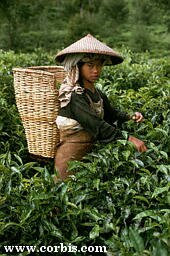|
Affectionally known as 'The Tea Plant', this species is used in cultivating tea in several countries today including the USSR, China, India, Korea, Indonesia, and many of the Russian Independant States.
In Australia, C.sinensis and other closely related species are used to make tea, most of the plantations being in Queensland. Australia still imports a great deal of tea (95%), even though it is produced in this country.
There are many legends from China and Japan about tea and how it was discovered. But both nations drank it as a calming drink, and it became woven in their deep culture.
The flower of Camellia sinensis is tiny, yet quite dainty, and unlike any other camellia - certainly nothing like Camellia japonica, for example. It has tiny cupped petals and a great head of stamens resembling a power-puff. The leaves are softer than Camellia japonica leaves, and the bush slow growing (in non-tropical areas) and woody.
So how do they make tea? Basically, the new growth is harvested by pickers, the leaves are graded and taken to be processed. Black Tea (the tea best-known to Australians) is created by drying and crushing these leaves. Green Tea is a slightly different process, and is more commonly available in Asia. You cannot make tea from other species like Camellia japonica - it tastes terrible!
|

The original Camellia sinensis used in tea has a white flower, green leaves, and green new growth. A pink form appeared later, it is more commonly seen available at nurseries; it has pink flowers with a lighter reverse, green leaves, and red new growth.
Herbal teas such as Rose Hip, Peppermint, Lemon, etc rarely contain any Camellia sinensis. Label varieties such as Earl Grey, English Breakfast, or Prince of Wales all contain Camellia sinensis. All tea that you get at the supermarket in tea bag form is Camellia sinensis or one of the other camellia species used to make tea.
|

We hope, if you are ever in our hemisphere, you will visit Australia and one of our camellia growing regions between May and September. In the meantime, have a look at these pages to learn more about camellias in Australia.
|

